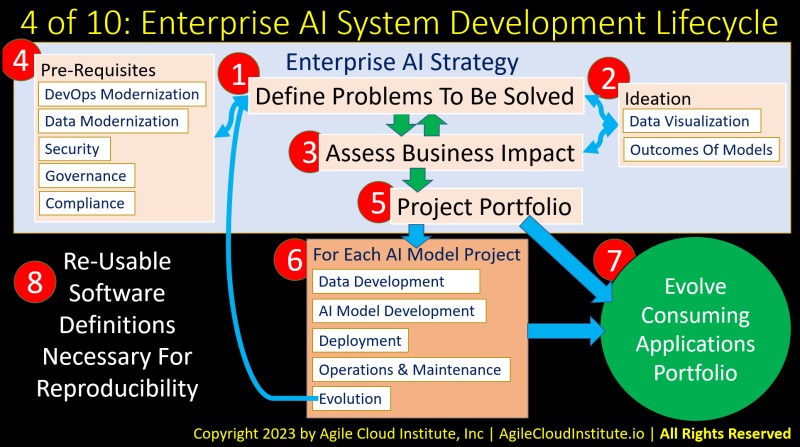Agile AI Platform Architecture with the Agile Cloud Manager
Part 4 of 10: Enterprise AI System Development Life Cycle
The entire transcript of this video is given below the video so that you can read and consume it at your own pace. We recommend that you both read and watch to make it easier to more completely grasp the material.

This next slide illustrates the system development life cycle for A.I. at an enterprise level.
A.I. is a team sport. Meaning that many different types of job functions will be involved in the system development life cycle for A.I.
Number one on the slide shows that A.I. strategy begins by defining the problems that need to be solved.
Remember that use cases for A.I. exist in every aspect of the organization. So there will be many problems to solve. The problems will need to be examined and prioritized.
Number two on the slide illustrates the ideation process.
Data engineers and data scientists can present visualizations of the data to make the case for different types of A.I. models.
And the outcomes of prototyped A.I. models can be explained.
Number three on the slide illustrates how the business impact of each A.I. use case needs to be assessed by cross functional teams including executives, finance people, and domain experts in various departments in the company.
The business impact will involve revisiting the problem definition. There can be a cyclical process of problem definition, ideation, and analysis of business impact.
Number four on the slide reminds us of the pre-requisites for A.I. that were illustrated in the problem definition slide earlier in this video.
Some of the pre-requisites for A.I. include:
- DevOps modernization.
- Data modernization.
- Security modernization.
- Governance.
- And compliance.
There is a reciprocal relationship between defining problems and assessing the state of your pre-requisites.
Pre-requisites are a big part of where Agile Cloud Manager comes into the A.I. system development life cycle.
Agile Cloud Manager can enable your organization to more quickly achieve the pre-requisite modernization that must occur before A.I. can be more fully implemented at the enterprise level. Agile Cloud Manager can also enable an organization to save a lot of money, which in turn can create budgets for your A.I. initiatives.
Number five on the slide illustrates how your organization’s project portfolio can be defined by the problems to be solved, the business impact, and the state of your pre-requisites.
Number six on the slide shows the requirements that need to be included with each new A.I. project. These requirements for each project include:
- Data development.
- A.I. model development.
- Deployment.
- Operations and Maintenance.
- And evolution, which links back to the problem definition phase.
Number seven on the slide illustrates that almost every application in your enterprise will need to evolve. Because almost every application in your enterprise might grow to consume A.I. models. And because A.I. models need to be replaced and evolved on an ongoing basis due to data drift and concept drift.
Number eight on the slide reminds us that everything needs to be software-defined in order to be efficient enough for your budgets to accommodate all of the ongoing change that is required.
Software-definition of everything is also required to ensure the reproducibility of the results of A.I. model experimentation and training.
Agile Cloud Manager can be used to greatly simplify the software-definition that is required in order for your enterprise A.I. platform to reach maturity.
Proceed to Part Five: Seed Each New AI Project With Standardized Project Templates
Back to Series Table Of Contents: Agile AI Platform Architecture With Agile Cloud Manager